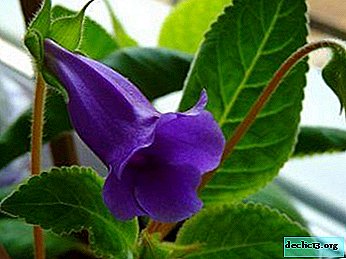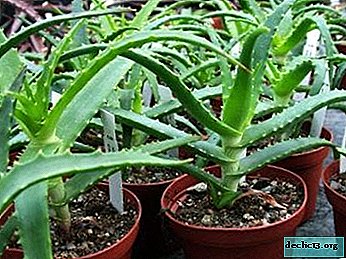Growing Catharanthus and caring for it in the garden and at home
 Katarantus is a spectacular shrub, strewn with numerous flowers. Translated from Greek, the name means "flawless flower."
Katarantus is a spectacular shrub, strewn with numerous flowers. Translated from Greek, the name means "flawless flower."
Therefore, everyone who saw him is of the opinion that the flower brings Mediterranean color to the house and gives a feeling of summer, warmth.
According to legend, with the advent of the catharantus, peace and mutual understanding reign in the family. Learn more about this amazing flower.
Features
The exact origin of the plant is difficult to determine. Most common in the tropical and subtropical forests of India, Indonesia, Malaysia, Cuba, Madagascar. In nature, the exotica height reaches up to 1.5 meters in height. But the catharanthus became a flower in the middle of the eighteenth century.
The plant is annual and perennial. It has a rod-shaped root system with thin processes that grows to a depth of 25 to 35 cm. A strong, specific smell emanates from the roots. Erect stems are strong and dense, on the tops there are branches. With age, they turn into a tree state. The leaves are oblong, both ends pointed.
The sheet length is 7cm. As a rule, they have a dark green color and glossy shine. In the center of the sheet plate passes a clearly visible, bright vein. Single flowers, large 3-3.5 cm in diameter, five-petalled.
Solid shade of petals:
- light lilac;
- white;
- pink;
- Orange.
In the center of the flower is a peephole, mostly of a contrasting color.
Externally, flowers of the catharanthus are similar to phlox, with the exception of phlox flowers collected in inflorescences, not single ones.Popular views and their photos
Pink
Among the numerous hybrids, the most famous species is Catharanthus roseus (Katarantus pink). In appearance, it closely resembles the periwinkle known to all. For a certain period of time, the sort of pink catharanthus in the scientific literature was erroneously baptized as “Pink Periwinkle” or “Madagascar Periwinkle”. This species is an evergreen, lushly flowering shrub. The stalk is fleshy, strong.
The foliage is deep green, glossy, as if smeared with wax. The shape of the leaves is correct with a central vein of beige hue.. The height of the bush reaches 60cm in height. Single flowers, have five petals. Their length is up to 5 cm in diameter.
The color is varied, from white to burgundy. Perhaps a combination of several shades. Katarantus pink is found in both an upright bush and an ampelous species.

Ampel subspecies
As for the ampelous subspecies of the catharanthus, flower growers also prefer them. Beautifully cascading flowers look in hanging flower pots, so they are often used to decorate vertical structures. Plants are distinguished by attractive lashes, decorated with bright red flowers along the entire length. They bloom at the ends of the shoots and in the axils of the leaves. The length of such a whip is approximately 75cm. The leaves are rounded, dark green.

You can find out about other types and varieties of Catharanthus here.
Ways to grow flowers their benefits
Even an inexperienced grower can grow catharanthus. The main thing is to follow the basic rules for breeding and landing. If this succeeds, then after a few months you can contemplate a lushly flowering plant. Exot is propagated as an indoor flower (perennial) or for open ground (an annual individual).
They breed cataract in three ways:
- seed;
- vegetative;
- division of rhizomes.
Sowing seeds
First of all, you should stock up on seed. It is sold in stock in any gardening store. However, before buying, you should pay attention to freshness, the term of packaging.
Sow seeds in late February - early March.
- Before sowing, seeds are soaked in an aqueous solution of Epin for 24 hours.
- Then, seeds are carefully planted in the prepared, room temperature soil.
- The immersion depth of the seeds is not more than 1cm.
- Top soil is sprayed with water from a spray bottle.
- Place the landing container in a mini greenhouse or simply cover it with transparent material (film, glass).
- The temperature should be maintained at not lower than + 25 ° C, aired daily.
- After 7-10 days you will see the first seedlings, then the shelter can be removed.
- When 3-4 leaves appear, the young plant should be dived.
Low cost seed propagation method, because the cost of a bag of seeds is ten times lower than that of a grown individual, not to mention the independent receipt of seed. This method is also characterized by a high percentage of germination. From fast-growing seedlings, a flowering plant is obtained by the beginning of summer.
About how to grow a catharanthus from seeds at home, read in our material.
Watch a video about sowing Katarantus seeds:
Cuttings
 The method is carried out in early spring after the circumcision procedure. Strong processes from the crown, 10 cm long, are left. The leaves are removed, leaving on top 2-3 pieces. The slice is treated with Kornevin powder. Then they are placed in a peat-sand mixture and covered with a transparent cap, creating a greenhouse effect.
The method is carried out in early spring after the circumcision procedure. Strong processes from the crown, 10 cm long, are left. The leaves are removed, leaving on top 2-3 pieces. The slice is treated with Kornevin powder. Then they are placed in a peat-sand mixture and covered with a transparent cap, creating a greenhouse effect.
Root formation will accelerate lower heating. Cuttings are regularly sprayed and watered with water, not forgetting to air the greenhouse. After 1 month, the roots hatch, and the seedlings should be transplanted into a new pot with high-quality soil.
Thanks to the method of cuttings, you can get a new plant identical to the mother.
We look at the video on how to cut the catharanthus correctly:
Bush division
This process is carried out during a plant transplant in a new pot. It is preferable to choose a healthy, adult individual. Depending on the size of the root system, the flower is divided into 2-3 parts.
- We extract the flower from the pot.
- We remove excess land.
- We determine the places of future slices.
- Separation is carried out with a sharp disinfected tool.
- Sections of sections are treated with an antiseptic, can be crushed with activated carbon.
- We plant plants in various containers.
This method is good because the plant is already grown, they quickly adapt to the new soil and go to growth.
Outdoor landing
 The plantation of catharanthus in open soil occurs exclusively in seedlings. In view of the many unsuccessful attempts by gardeners to plant a plant directly in the ground.
The plantation of catharanthus in open soil occurs exclusively in seedlings. In view of the many unsuccessful attempts by gardeners to plant a plant directly in the ground.
Seedlings are obtained by the above method, and when the temperature outside the window reaches + 20 ° C, night frosts are bypassed, planted in the ground. Such conditions will help seedlings to quickly adapt to new conditions and give beautiful shoots.
At the same time, around the beginning of summer, young cuttings root in the open ground. For quick acclimatization, they are tempered on the balcony with the onset of heat.
Before planting, soil in the garden in the flowerbed should be dug up, adding a little gravel or expanded clay.Care
At home
Katarantus, of course, is a whimsical flower, however, to achieve lush and long flowering is possible only subject to certain rules.
- Room temperature in the summer is in the range + 25-26 ° С.
- Winter temperature + 14-17 ° C.
- A temperature of + 10 ° C is critical for the plant.
- A tropical shrub loves light, but in hot periods you need to be careful with the sun's rays.
- It is better to choose a window sill from the western or eastern side.
- In addition to lighting, watering is still important. The soil should not completely dry out; the plant prefers a moist growth environment.
- Requires moist air in the room.
- Shrub likes regular spraying.
- For cultivation, light, loose soil, without excess salt, is suitable.
- In the spring and summer, to feed exot mineral fertilizers based on phosphorus and potassium.
- Use fertilizer every 2 weeks.
- In the autumn-winter period, top dressing should be excluded altogether.
You can find out about the features of care, planting and cultivation of Catharanthus, as well as see a photo of the plant, here.
In the garden on the flowerbed
 The main care for street caterpillar is to eliminate weeds, pruning, watering and fertilizing the soil.
The main care for street caterpillar is to eliminate weeds, pruning, watering and fertilizing the soil.
- As for the weeds, they are eliminated while the plant is small. When the flower grows up - he will cope with them.
- Humidification is required plentiful. Water-loving shrub. With a lack of fluid, the foliage begins to curl and turn yellow. And after watering, after 30 minutes, it is again gaining tonus. Excess moisture is also not required. With prolonged cold and rainy weather, an awning should be built above the flower. Hide the plant there. Low temperature and abundant moisture are a negative combination for cataractus.
- It is recommended to use mineral fertilizers during flowering. Nutrients are best chosen in liquid form and added to the root along with watering. It will be enough to fertilize the soil once every 2 weeks. In no case should you increase the dosage, so you can damage the roots.
Katarantus responds well to ash, as a mineral fertilizer. For this, 100 g of ash are dissolved in 10 liters of water.
- Withered, withered, or yellow leaves must be removed. Also, faded flowers should be cut. These measures are necessary so that the appearance of the flower remains attractive.
- With the advent of cold weather, the catharanthus is dug up, planted in a pot and brought into a room with a temperature of + 15-17 ° C. In winter, you can not moisten the exot, water procedures can be restored with the arrival of heat.
Diseases and Pests
The tropical shrub is quite resistant to damage by various diseases and parasites. However, with abundant watering, fungal infections occur, which are expressed by brown spots on the leaves and rotting of the root system. With dry air, harmful insects - scabies and spider mites - spread in the room. In open ground, aphids can attack a flower.
Before you bring catharanthus into the house, inspect it so as not to infect other plants. If necessary, it is worth treating the foliage with chemicals. So, cultivating this exotic guest both in the house and on the street will not cause much trouble.
Due to its unpretentious nature, it acclimatized perfectly in a temperate climate. Therefore, all that is really needed to grow a catharanthus is desire and some skills.

















